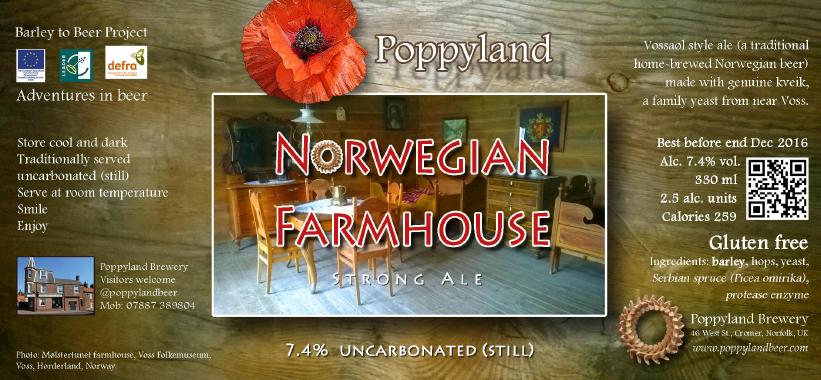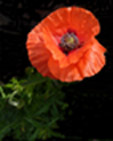Norwegian Farmhouse
Uncarbonated Norwegian style 'maltøl', or 'vossaøl' 7.4% in 330 ml bottles

Brewed on: 8.12.2015 Bottled: January 2016 onwards. Released from 29.1.2016
I became interested in traditional Norwegian beer (maltøl) through the blog of Lars Marius Garshol, an IT consultant and resident of Oslo. He blogs on, amongst other things, the brewing traditions of Baltic countries, not least that of his native Norway. In it I discovered that the traditional brewers use a type of yeast (often containing various strains) that they call 'kveik' (pronounced kva-eek). It was handed down in the family from one generation to the next and so is sometimes referred to as a 'family yeast'. But brewers in a community, if their yeast goes bad, weakens or dies off, will get some from a friend or neighbour, so perhaps a more apt term is a 'community yeast'. I encourage you to read Lars' blogs as they are very enlightening original research. But furthermore, Lars lodged some samples of kveik at the National Collection of Yeast Cultures (NCYC) which is in Norwich and around the same time I had developed a relationship with them after a group of their staff visited Poppyland Brewery on a fact-finding tour of local breweries.
With this background I found myself drawn to the idea of brewing with kveik at Poppyland Brewery but not having tasted any Norwegian home-brewed beer before I had no idea what I was aiming at and the recipe details available were a little scant. So when holiday plans were discussed with Mrs Brewer it lead to a trip to Norway to track down a traditional brewer and get to taste their 'vossaøl'. You can read about the trip in several of my own blogs entitled Trip to Norway, parts 1 to 4.
I am very grateful to John Nornes of Dyrvedalen near Voss for hosting a tasting of vossaøl (meaning the tradition ale from Voss) at his house and for being very open about brewing methods and ingredients in his beers. He also gave me a sample of kveik with which I brewed this beer. An essential ingredient of these old Norwegian beers is the liquor used in the brewing and water for washing down which is an infusion made from juniper - the branches and leaves, not the berries. Therein lay my problem: I had the malts, the yeast and a good idea of the recipe but I didn't have juniper. In Norway it is widespread and abundant, like grass but in the UK it is localised, chiefly found in Scotland and local calcareous soils elsewhere and generally is in decline. Most of the English sites will be in nature reserves and so it is rather precious, protected and I wouldn't forage it on ethical grounds. So I had to find an alternative to wild juniper - either cultivated juniper (Juniperus communis) or a substitute. To cut a long story short, I used Serbian spruce (Picea omorika) as it was available as a Christmas tree in December and I thought the flavour and aroma resembled what I had tasted in Norway.
It was a long brew day, as the Norwegians mash for three hours and then boil for four hours to really concentrate the flavours and to make a very strong beer. Another unique trait is that they pitch the kveik when the wort is almost 40°C, which is a temperature that would kill most yeast strains. I pitched at 37°C, as recommended by John Nornes's cousin Bjørne and they keep the fermenting vessel very warm. The kveik rips through most of the sugars in a couple of days before calming down to finish the job more slowly.
The photographs on the label were taken on my phone of the farmhouse at Voss Folkemuseum and the wooden walls of Bjørne Røthes' ancient brewhouse in Dyrvedalen near Voss.
I was also inspired to make a yeast ring with which the farmhouse brewers would preserve the kveik for brewing at a later date. I blogged about how to make one of these and it was read 17,500 times in the first two days.

Another summary of the Norwegian farmhouse brewing tradition can be found here.
Tasting notes
"Small brown coarse head in middle of glass quickly dissolves. Hazy deep dark reddish brown body. Fruity chocolatey roasty earthy aroma with toffee notes. I recognize the kveik character. Sweetish roasty caramelly taste with fruity notes. Mid-bodied. Flattish, soft mouthfeel, lingering metal. Sweetish metallic herbal aftertaste with floral bitterish notes. Strange. Wood? Lingering pine needle bitterness. No real orange, but the funky part of the kveik flavour is there; in fact, stronger than usually with Sigmund's kveik. Waxy notes." Courtesy of Lars Marius Garshol
What the Customers say
Oliva del Rosario, my CAMRA Brewery Liason Officer: "Red brown ale with a gorgeous caramel aroma with tones of raisins and malt reminding you of a rich and fruity Christmas Pudding. It has a silky and creamy mouthfeel with a rich caramel malty taste combined with a powerful herbal bitterness which ends in a subtle smooth and sweet aftertaste, it will compliment a cheese board extremely well"
Free from
Gluten-free (<10ppm). Tested independently 12.1.2016
Martin Warren, The Poppyland Brewer
 Poppyland Beer
Poppyland Beer